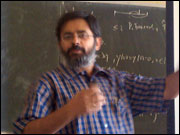|
|
Заседания Санкт-Петербургского математического общества
24 мая 2011 г. 18:00, г. Санкт-Петербург, ПОМИ, Фонтанка, 27, аудитория 311
|
|
|
|
|
|
|
Diophantine equations of the form $f(x)=g(y)$
B. Sury
Bangalore
|
| Количество просмотров: |
| Эта страница: | 240 |

|
Аннотация:
Questions on counting usually involve finding integer solutions $x$, $y$ of equations of the form $f(x)=g(y)$ for polynomials $f$, $g$ with integer or rational coefficients. For instance, if $a$, $b$, $c$ are rational and $ab$ is non-zero, then for $m>n>2$, the Diophantine equation $aC^m_x+bC^n_y=c$ has only finitely many integer solutions $x$, $y$. Another natural example comes from counting lattice points in generalized octahedra. The number of integral points on the $n$-dimensional octahedron $|x_1|+|x_2|+\dots+|x_n|\le r$ is given by the polynomial expression $p_n(r)=\sum\limits_{i=0}^n 2^i{\mathrm C}^i_n{\mathrm C}^i_r$ and the question of whether two octahedra of different dimensions $m,n$ can contain the same number of integral points becomes equivalent to the solvability of $p_m(x)=p_n(y)$ in integers $x,y$. It turns out that when $m>n>1$, the above equation has only finitely many integral solutions.
The above results and many others appearing in the last decade have been made possible by a beautiful theorem of Yuri Bilu & Robert Tichy from 2000. For an absolutely irreducible polynomial $F(x,y)$ in $\mathbb Z[x,y]$, a celebrated 1929 theorem due to Siegel shows the finiteness of the number of integer solutions of $F(x,y)=0$ except when the (projective completion of the) curve defined by $F(x,y)=0$ has genus 0 and has at most 2 points at infinity. This theorem generalizes also to $S$-integers in algebraic number fields. But, Siegel's theorem is ineffective. Bilu & Tichy obtained for the equation $f(x)=g(y)$ with $f$, $g$ polynomials over $\mathbb Q$, a remarkable theorem which makes Siegel's theorem much more explicit (although still ineffective). Here, we discuss some Diophantine equations where Bilu-Tichy theorem applies and some others where elementary methods or methods of the Chebotarev density theorem apply.
Язык доклада: английский
|
|



 Обратная связь:
Обратная связь: Пользовательское соглашение
Пользовательское соглашение
 Регистрация посетителей портала
Регистрация посетителей портала Логотипы
Логотипы